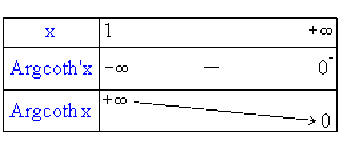Fonction Argument cotangente hyperbolique de x
Définition :
L'application \(\textrm{coth}\) : \(\mathbb{R}^{\ast} \to ]-\infty,-1[ \cup]1,+\infty[\) continue et strictement décroissante admet une fonction réciproque notée
\(\textrm{Argcoth } : ]-\infty, -1[ \cup ]1,+\infty[\to \mathbb{R}^{\ast}\)
\(y = \textrm{Argcoth }x \Leftrightarrow x = \textrm{coth }y\)
\(x\in ]-\infty,-1[\cup ]1, + \infty[ \textrm{ et } y \in \mathbb{R}^{\ast}\)
\(\begin{array}{llr} \textrm{sh } (\textrm{Argcoth }x) = \frac{\arrowvert x\arrowvert}{x\sqrt{x^{2}-1}} & \forall x \in ]-\infty,-1[ \cup ]1,+\infty[\\ \textrm{ch } (\textrm{Argcoth }x) = \frac{\arrowvert x\arrowvert}{\sqrt{x^{2}-1}}& \forall x \in ]-\infty, -1[\cup]1,+\infty[ \\\textrm{th } (\textrm{Argcoth }x) = \frac{1}{x} \qquad& \forall x \in ]-\infty,-1[ \cup]1,+\infty[\\ \textrm{coth } (\textrm{Argcoth }x) = x \qquad& \forall x \in ]-\infty,-1[ \cup]1,+\infty[\end{array}\)
fonction impaire, d'où une étude sur \(D_{e} = ]1, +\infty[\)
fonction dérivable sur \(D_{e}\) et :
\(\textrm{Argcoth'}x = \frac{1}{\textrm{coth}'(\textrm{Argcoth }x)} = \frac{1}{1-\textrm{coth}^{2}(\textrm{Argcoth }x)} = \frac{1}{1-x^{2}}<0\)
donc fonction décroissante sur \(D_{e}\).
tableau de variation :

Représentation graphique de \(\textrm{Argcoth }x\)

Expression logarithmique de \(\textrm{Argcoth }x\)
\(\forall x \in ]-\infty,-1[\cup]1,+\infty[ \qquad \textrm{Argcoth }x = \frac{1}{2} \ln \frac{x+1}{x-1}\)
Démonstration :
\(\forall (x, y) \in ]-\infty,-1[ \cup ]1,+\infty[\times \mathbb{R}^{\ast},\)
\(y = \textrm{Argcoth }x \Leftrightarrow x = \textrm{coth }y = \frac{e^{y} + e^{-y}}{e^{y} - e^{-y}} = \frac{e^{2y}+1}{e^{2y} - 1}\)
\(x\left(e^{2y}-1 \right) = e^{2y} + 1 \Leftrightarrow e^{2y} = \frac{x+1}{x-1}\)
\(y = \frac{1}{2} \ln \frac{x+1}{x-1}\)
On retrouve la fonction dérivée :
\(\left[\frac{1}{2}\ln\left(\frac{x+1}{x-1}\right)\right]' = \frac{1}{2} \left[\ln(x+1) - \ln(x-1)\right]' = \frac{1}{2}\left(\frac{1}{x+1} - \frac{1}{x-1}\right)\)
\(= \frac{1}{x^{2}-1} = \textrm{Argcoth}'x\)